~ JAMES SIMMONS ~
1741-1807
CANTERBURY
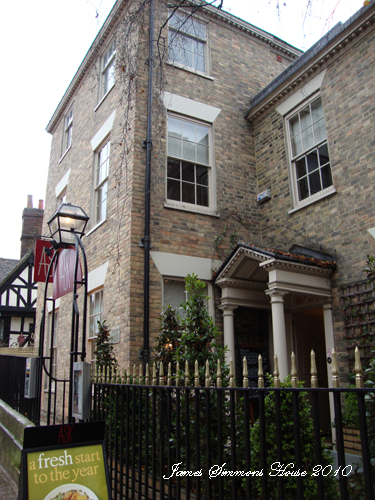 __
__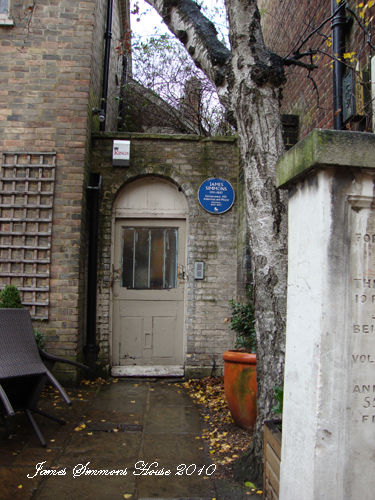
1807, Feb. Died, James SIMMONS, printer and bookseller at Canterbury, whose life is a striking instance of what may be effected by industry and perseverance. "Mankind" observes the writer of an account of the subject of his memoir, "are but too fond of contemplating heroes; and launching their admiration on exploits, which they can never hope either to imitate or excel." Knowledge, estimated with reference to usefulness, is only to be gained, nevertheless by an attentive investigation of the history of the middle classes of society, whose biography alone abounds with practical instruction. James SIMMONS, who afterwards sat in parliament for his native place, was born in an obscure part of the city of Canterbury, immediately in the vicinity of its cathedral, about the year 1740. His father (*William) was a barber (*perukemaker), whose circumstances were confessedly poor, although himself was of honest repute; and his son was educated at the King's School (*1749-55), in Canterbury, an excellent institution, which was founded by Henry VIII. Being sent to London, while a boy, James became an apprentice to Mr. Thomas GREENHILL (*c. 1757), an eminent stationer, residing nearly opposite the Mansion house, but whose residence has since been converted into a banking house; thus, adopting the witticism of this gentlemen's biographer, "still keeping up, although not in its ancient firm, at least its ancient employment, stationers and bankers being both dealers in paper." Mr. Simmons, at length, entered into business on his own account when becoming a liveryman, he was shortly after put in nomination for the office of sheriff. This occurred twice, during 1802 and 1806; but it was represented that the state of his health would incapacitate him for sustaining the arduous duties which the shrievalty necessarily imposes upon those who undertake it. Notwithstanding, therefore, the advantages he might have derived by continuing to reside in the capital, Mr. Simmons, still panting for his native air, repaired, about the year 1768, to Canterbury, where he established a printing-office, with the management of which he had previously made himself acquainted. He was at this period the only printer in Kent. The foundation both of his celebrity and property, property being the consequence of real celebrity, was here laid by him in the publication of the newspaper entitled the Kentish Gazette. Before his time, the Kentish Post, or Canterbury News, was the only paper devoted to that extensive opulent county; it consisted of just four foolscap folio pages, containing two or three advertisements; and was adorned with a woodcut, that occupied full one-third of the first leaf. He could not but improve on such a plan. Introducing a new type, and a new taste, his undertaking at once succeeded. Mr. SIMMONS soon became the first stationer, bookseller, &c. in the city that gave him birth. Mr. Simmons was in politics a whig; and was, during the short period the Rockingham administration were in power, appointed distributor of stamps for the county of Kent; the emoluments of which, estimated as considerable, are known to have essentially contributed to his actual wealth. Declining, from prudential views, the contests of party, and having already filled the highest offices of his native place, Mr. SIMMONS turned his attention to objects of general and practical utility. The first public act of this kind, in which this praiseworthy zeal became manifest, was the tender of his services to regulate the improvements agreed to be introduced into Canterbury; and such were the ability and attention evinced by him, especially as to the paving of the city, that he received the thanks of the corporation, accompanied with a piece of plate, of the value of £50. He was engaged in another great work. In 1794, Messrs. Simmons and Royle gave a premium of £2450 for thirty years lease of Abbot's and King's Mill; and they expended on the building, together with its improvements, to the amount of £8000 more.
*I added these notes
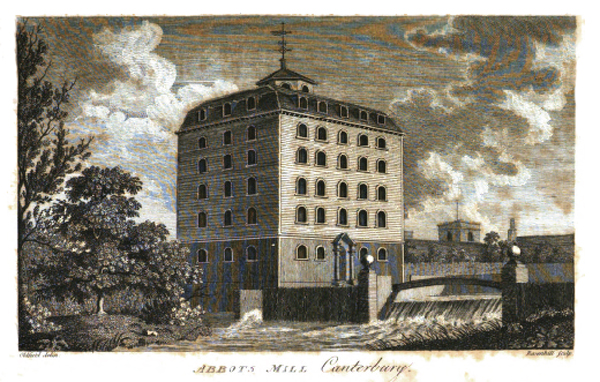
Mr. SMEATON, however, the celebrated engineer, undertook the erection of a new mill, with such a power as should turn six, and even eight pair of shears, for the regular supply of the Canterbury market with flour. Instead of converting this useful design (which was finished by Mr. Abbot, of Canterbury, in a masterly style,) into a monopoly for the oppression of the inhabitants, and the avaricious accumulation of wealth, Mr. SIMMONS was enabled to realize projects infinitely more gratifying to his feelings. Its returns have been computed at £40,000 per annum; and he was also enabled to keep down the price of meal, and the assize of bread. Determined to effect both these ends, he cheerfully assisted the magistrates in adjusting the value of the quartern loaf; and, in 1800, issued an advertisement, by which he publicly invited the industrious poor to come in person for a supply of their necessities. Sensible of the various benefits extended to their city by this spirited citizen, in the accomplishment of which he had expended about two thousand guineas, his townsmen, at the general election in 1806, exhibited their sense of his public conduct, by electing him one of their representatives in parliament. But Mr. SIMMONS did not long enjoy this trust. He died as he had lived, however, in the service of those by whom it was conferred, during the February of 1807, whilst attending his duty in the house of commons. 1839
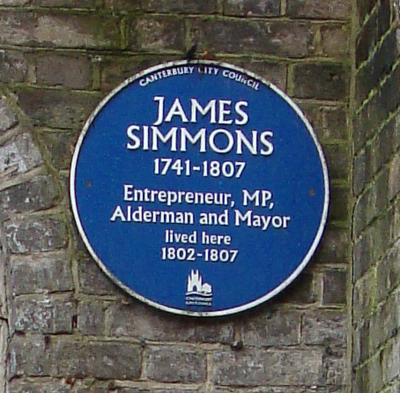
Became a Freeman of Canterbury by Patrimony - James SIMMONS, of London, stationer, 1767 (Married Charlotte MANTELL)
June 2, 1808 - The character which you have given of the late Mr. SIMMONS of Canterbury, in p. 177 of your volume for the year 1807, was such as he well merited.
Mr. Hasted, in his History of Kent, gives the following account of one of the public spirited works of this gentleman; but it deserves to be better known; and if the following particulars, which I took on a late visit to Canterbury, appear to you to be worth inserting in your Miscellany, they are much at your service, as are the inclosed drawings, from the elegant pencil of a friend who accompanied me. (see plate 1)
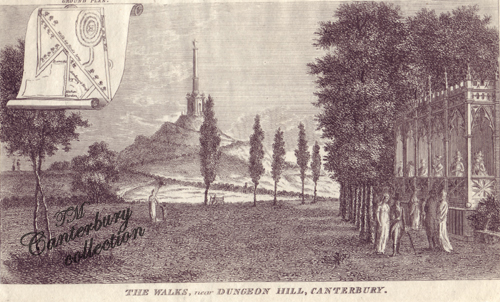
Mr. Hasted says, "The Dungeon, or Dane John field, adjoins to, but within the walls of the City, at the S.E. corner of this field there is thrown up a vast artificial mount, to all appearance circular, having a deep ditch, from which, no doubt, the earth was taken; it is a great deal higher than the wall ever was, when entire. From the tope is a clear view of the City, as well as of a great extent of the adjoining country. On the top formerly stood a windmill. The field consisted of very uneven ground, and had never been levelled. On the outward side of the wall, opposite to this mount, separated by the City ditch and a high road, is another smaller mount." Vol. IV. p. 430
"In 1790, the Dungeon field was with much labour leveled, and planted with trees, and beautifully laid out in walks, for the use and amusement of the publick, at the expence of upwards of £1000 by a private, but liberal minded citizen, James SIMMONS, esq., banker, and an alderman of the City, to whom the Corporation granted it for this purpose for life, rent-free." P. 423
"When the Riding gate was pulled down, Mr. SIMMONS, when making these improvements, erected a very spacious and lofty arch over the road, and continued the terrace-walk formed on the City wall over it at his sole expence." P. 415
The piece of ground which belongs to the Corporation contains about five acres; the circuit nearly half a mile. A terrace is carried along the side of the wall, within three or four feet of the top, so that it forms a parapet. It commands a view of the surrounding country. The ground was originally full of pits, was in the rudest state, and was in the rudest state, and was used for exercising horses, laying dung and rubbish, &c. The walks, in it and across it, which form a communication from one part of the City to another, are graveled, trees planted by the sides, and the grass kept in the nicest order. No horses or carriages are admitted. A gardener, who has the care of it, has a small neat house within it, in the Gothic style.
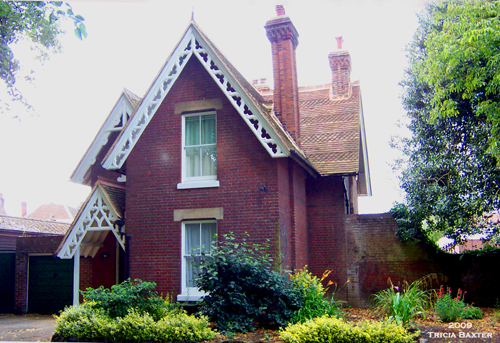
On the mount mentioned by Mr. Hasted, is now erected a square stone building, from which rises a column. The ascent to it is by an easy spiral walk; the building is inclosed by iron rails, and on each side is a seat for the accommodation of visitors, which is also of iron, not liable to be damaged by the folly of inconsiderate boys.
The second only of the following Inscriptions was there, when we visited it; the other having been damaged by the frost, and having been taken down to be repaired; but we got a copy from the stone mason.

1. "This field and hill were improved, and these terraces, walks, and plantations made in the year 1790, for the use of the publick at the sole expence of James SIMMONS esq. of this City, alderman and Banker. To perpetuate the memory of which generous transaction, and as a mark of gratitude for his other public services, this Pillar was erected by voluntary subscription in 1803."
2. "The Mayor and Commonalty of this antient City, in consideration of the expensive improvements lately made in this field, unanimously resolved, in 1802, to appropriate the same in perpetuity to the use of the publick, and to endow it with sixty pounds a year, for the maintenance and support of the terraces, walks, and plantations, payable out of the Chamber."
The horse-barracks adjoin to this field on one side, and near them is an open seat, covered at top, like the musick-gallery at Vauxhall, in which the band of such regiment as happens to be quartered in the town, often entertains the company in a summer evening.
Yours, &c. A Traveller
Gent. Magazine, June 1808
Partnered with Henry GIPPS to open the Canterbury Bank
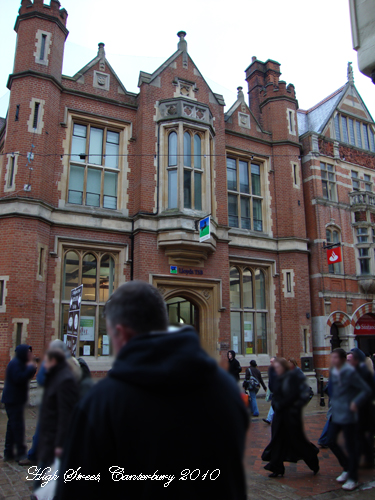
James Simmons was the son of a barber and was born in 1740 in an obscure part of the city. He was educated at the King's School, and subsequently apprenticed to Thomas Greenhill, stationer, of London. In addition to founding the Kentish Gazette Simmons was appointed distributor of stamps for the County of Kent, and in company with Kirkby established about 1780 a circulating library at the Kings Arms Printing Office, with a reading and newspaper room, the terms of subscription being : To the library-Reading Room and Newspapers by the year 1 lls. 6d. Half year 17s. Quarter 9s. six weeks five shillings. To the Reading Room and Newspapers only by the year 1 Is. Half year lls. Quarter 6s. To the Library only by the year 1 Is. Half year lls. Quarter 6s. [Advt. in the Kentish Gazette].
James Simmons served the respective offices of Alderman, Mayor and Member of Parliament for Canterbury, and undertook several city improvements, most notable of all being the laying out of the Dane John Gardens. He died at Westminster on Thursday January 22nd, 1807 in his 66th year. Amongst notable books printed and published by the firm of Simmons & Kirkby was the first edition of Hasted's History of Kent, 1778 and the same authors History of Canterbury, 1799.
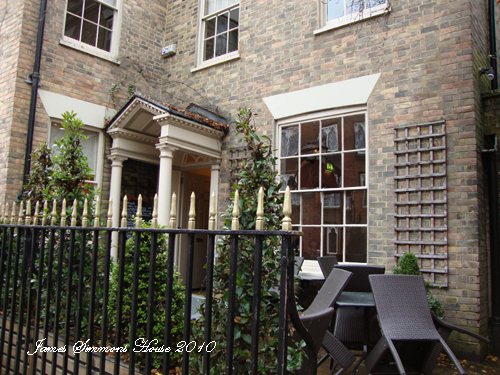
October 1802 - A subscription has been lately opened, and now lies at the banks and libraries in the city of Canterbury, for the purpose of erecting, at the expence of the public, an elegant stone pillar, on the summit of the Dane John Hill, with iron rails and commodious seats around it, "in commemoration, and expressive of, the costly improvements made on the Dane John Field, in the year 1790, by Mr. Alderman Simmons, and of his other public services" as it is expressly stated in the papers; also to commemorate the "resolution of the mayor and commonalty of the city, to devote the terraces, walks, and field, in perpetuity, to the public use." N.B. A drawing of the intended pillar has been left for public inspection at Mr. Bistrow's Library. - The Monthly Magazine 1802
"T.S. communicates the following anecdote relative to the late Lord Rokeby: " When he represented the city of Canterbury, nearly fifty years ago, he laid a wager of 10l. with the late Alderman Simmons, of that city, that they both should live to see the day when the Bank of England would refuse to pay cash for their own notes. About thirty years after, the Bank suspended cash payments; and his Lordship, when upwards of eighty years of age, rode on his poney from Norton to Canterbury, publicly to demand his wager at the market table of the Alderman, which was instantly paid. At his death upwards of 40,000 guineas were found in his house." The Gentlemen's Magazine 1819
A historical description of the metropolitan Christ Church Canterbury, 1783, printed by Simmons and Kirkby, 156 pages
A walk in and about the City of Canterbury - William Gostling 1779 (Simmons & Kirkby)
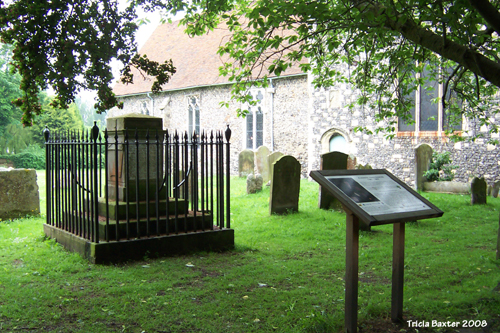
The churchyard contains one monument, which the citizens ought, out of gratitude, to take under their charge. It is the tomb of worthy Alderman Simmons, who, at the beginning of the present century, converted what was then known as the Dane John Field, into a beautiful garden and recreation ground for the citizens. This he did at a cost of £1500. We read on his monument (which much needs some "Old Mortality's" loving hand to set it in order) (see below). The Alderman died in 1807.
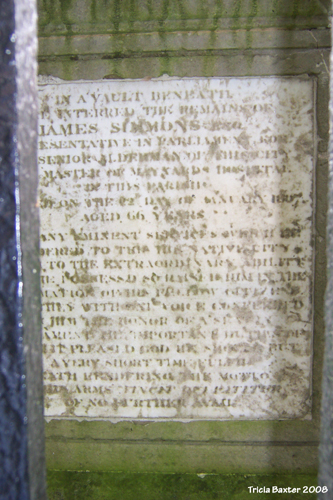
The epitaph on Alderman James Simmons tomb
*died in London
"In a vault beneath is interred the remains of James Simmons esq. Representative in parliament and Senior Alderman of the city. Master of Maynards Hospital in this Parish
He died on the 22nd day of Janry 1807
Aged 66 years
Many eminent services which he rendered to this his native city. To the extraordinary ability that he possessed, so raised him in the estimation of his fellow citizens, that they, with one voice, conferred on him the honor of a seat in Parliament, the important duties of which it pleased God he should but a very short time fulfil. Death rendered the motto of his arms "Vincit qui patitur," Patience wins"
PLEASE CONTACT ME IF YOU HAVE ANY FURTHER INFORMATION TO SHARE
